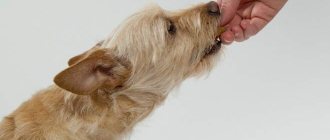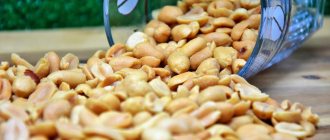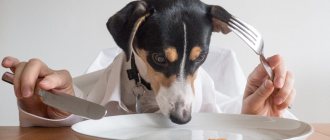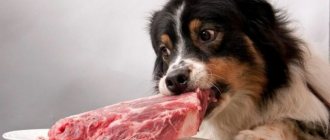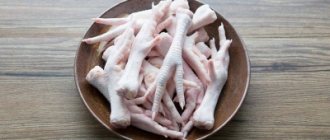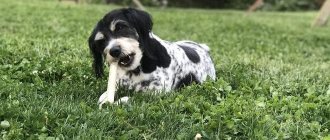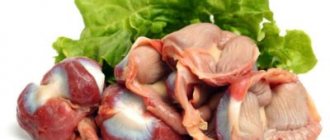It is widely known that the ancestors of dogs were wolves - predators that fed on the meat and bones of their prey. The logical conclusion follows from this: dogs eat bones. This is true, but only partly true for our favorites. Modern dogs are more sensitive, since when breeding the breed, breeders often sacrificed the animals' endurance, preferring external characteristics to health. In this article we will figure out which bones can be given to a dog, and also answer the question - what awaits an animal that eats prohibited chicken bones.
Can I give it to a dog?
It is difficult to answer this question unequivocally. Most veterinarians are inclined to believe that this food should not be given to dogs. But there are other points of view.
It is worth understanding the reasons for the ban and options for including bones in the diet.
What kind of chicken bones can you give?
Permitted types:
Chicken necks. They contain a lot of useful substances. They are given to animals whole, but not more than twice a week. There are no dangerous small bones in the necks, so they can be included in the diet of dogs of large and small breeds.- Heads. You just need to remove the beak, because if the dog swallows this part, it can injure the esophagus. Such by-products will be of particular benefit to racing breeds, because... saturate the pet’s body with essential nutrients.
- Cartilage. No harm is caused. They are considered absolutely safe for pets.
What is the danger for dogs
When chewed, tubular bones break and turn into sharp fragments. When they enter the gastrointestinal tract, they damage the mucous membrane of the digestive organs. This negatively affects the condition of the animal.
Bones contain dangerous bacteria. When exposed to an acidic environment, they begin to actively multiply and cause poisoning.
Which chicken bones are prohibited from being added to food?
Tubular bones from the wings and thighs of a bird can cause serious harm to an adult dog and a small puppy. Feeding them to your pet is strictly prohibited. You should also not give your animal chicken feet. The consequences of their use can be disastrous.
Can it be given to puppies?
Bones are especially harmful to puppies. Their mucous membranes are still very delicate, so the gastrointestinal tract is easy to damage. Hard bones damage tooth enamel when chewed and lead to the formation of an incorrect bite.
Puppies can only be fed chicken necks and heads. They are introduced into the diet no earlier than at four months, given once a week. More frequent consumption of offal can negatively affect the condition of the puppy.
At what age can a puppy be given bones?
Well, if you can sometimes feed your dog bones, then at what age? Veterinarians believe that the earliest age when a dog can be treated to a bone is 3-4 months
. And then, provided that the bones are large enough that the puppy definitely cannot chew them. When all the cartilage and meat have been eaten, the bone must be taken away from the baby without regret, so that he does not bite off and swallow its sharp fragment. When giving a small puppy a bone, the owner must keep a close eye on it.
From all of the above, the following conclusion follows:
- The only suitable bones for dogs are beef bones
; - Dogs can only be given bones in the presence of the owner
. Moreover, it does not matter what age the animal is: both an adult dog and a puppy can suffer from a sharp bone fragment; - It is better to give the dog bones after a short heat treatment, but certainly from a healthy cow
. You should not buy bones in dubious places, even if they are very cheap; - Old, stale bones are dangerous
(including those that your dog might dig up in the ground while walking). They can seriously poison an animal; - Bare bones (without meat and cartilage) are absolutely useless
. The dog cannot get enough of them or get any nutritional benefit from them. The only advantage of bones without cartilage and meat is that they can act as a toy for the animal; - You can periodically treat your dog to beef bones
(once or twice a month), but you cannot literally feed the animal bones (any kind) every day. Dogs require meat, which is usually very little on the bones; - It is not advisable to give bones to dogs that have problems with teeth and gums
to avoid injury. It is also better to discard bones if the animal has problems with the digestive system, for example, constipation; - You should not treat very young puppies or older dogs with bones
. Hard bones can definitely harm their teeth. If desired, it is better to treat old pets with a tendon bone from a pet store; - Any bone is potentially dangerous
(even a large beef bone). Therefore, it is better to always keep the number and address of the veterinary clinic at hand so that, if necessary, you can immediately deliver the dog to a doctor. If, after being treated to a bone, the dog begins to choke, cough, if it salivates profusely, vomits (or has the urge to vomit), or has blood in its stool or vomit, then a visit to the doctor cannot be postponed until later.
In what form can it be given?
It is not enough just to choose bones that are safe for your pet. You need to know in what form they can be used for feeding.
Are boiled bones allowed?
Boiled chicken bones are not digested in the stomach and cause constipation.
During heat treatment, all beneficial substances are destroyed. Boiled bones do not contain anything nutritious in their composition. They settle in the intestines and gradually accumulate, which leads to a deterioration in the dog’s condition.
Is it possible to give raw
The best option would be raw heads or necks.
To destroy pathogenic microorganisms, it is recommended to pour boiling water over offal. This way you can protect your pet from infection.
Bone minced chicken
It is prepared by chopping boiled bones and adding poultry meat. The finished product can be given to animals in small portions maximum three times a week. Its more frequent use leads to the accumulation of meat and bone mass residues in the intestines.
This food is often mixed with porridge and chopped vegetables. As a result, intestinal peristalsis improves, and undigested particles of minced meat are quickly eliminated from the animal’s body.
Industrial bones
Knowing why you can’t give bones to dogs, but wanting to satisfy the natural needs of the animal, you can offer him industrial analogues.
There are currently several alternatives;
- Calcium. Aimed at forming and protecting tooth enamel. They are given to older animals to maintain the musculoskeletal system. Shepherds, huskies and other large breeds can be given one piece per day; decorative breeds are recommended to be divided into several parts.
- From tendons. These products are good for removing tartar and cleaning teeth, as well as for dogs with allergies. The puppy is able to forget about the world around him for several hours and engage in gnawing on them.
- Gelatin. In addition to protecting and caring for teeth, they contain collagen and beneficial minerals that animals need. Especially useful for pregnant dogs.
- Chicken. To answer the question in the affirmative: is it possible to give a dog chicken bones, this version of industrially produced bones will help. In terms of taste, they are identical to the natural product.
Important! Just like regular bones, store-bought treats can become dangerous. Puppies and toy breeds can choke on them, so they should be given under the supervision of their owners.
Consequences of use
Eating tubular bones can lead to serious consequences.
Among them are:
Damage to the oral mucosa. As a result of the injuries received, stomatitis and periodontal disease develop.- Chips of tooth enamel, grinding of teeth. Such damage provokes the appearance of pulpitis and caries.
- Sticking of bone particles in the esophagus. Threats of suffocation.
- Damage to the pharynx, trachea. The animal suffers from acute pain.
- Perforation of the digestive organs. When such problems occur, internal bleeding occurs. It is possible that feces and stomach contents may leak into the peritoneal cavity. The animal needs surgery. There is a risk of developing sepsis and peritonitis. The dog may die.
- Sticking of bone particles in the anus, colon. In the best case scenario, constipation will occur. In the worst case, intoxication occurs due to intestinal obstruction.
If your pet has eaten such food, its condition should be monitored for 2-3 days. The following changes should cause alarm:
- loss of appetite or complete refusal to eat;
- clearly expressed anxiety;
lethargy, passivity;- appearance of cough;
- excessive drooling;
- gagging;
- whining;
- the presence of blood in the stool;
- bleeding;
- constipation.
Any of these symptoms should be a reason to contact your veterinarian.
If the incident of bone consumption was isolated, the pet’s condition has not worsened, there is no cause for concern. The pieces pass out on their own in the feces.
Sometimes your pet needs help to cleanse its intestines to avoid negative consequences . A wax candle (a small piece) that needs to be fed to the animal will help with this.
When it enters the gastrointestinal tract, it begins to melt, envelops sharp particles and promotes their safe removal from the body.
For a small breed dog, three centimeters of a church candle will be enough. Large dogs need to be fed about half.
An hour and a half after this procedure, the pet is given its usual food. It is noted that the risk of damage to the mucous membranes is significantly higher if the stomach is empty.
You should give your dog a candle three times a day. You need to use only natural products. Paraffin is absolutely useless.
It is strictly forbidden to induce vomiting or use laxatives. When performing such actions, the walls of the gastrointestinal tract begin to contract, and sharp bone particles can dig into them.
Harm from hollow chicken bones
Among the consequences of regular or even one-time eating of bones, the following are worth highlighting:
- tooth loss, damage;
- malocclusion, which in the future can lead to a number of serious diseases;
- caries has also not been canceled;
- getting stuck in the dog’s esophagus or throat, which can lead not just to injury, but to death through suffocation (in any case, surgery cannot be avoided);
- mechanical damage with sharp edges in the stomach and intestines, which will inevitably lead to ulcers and internal bleeding;
- vomiting, loose stools or, conversely, constipation - these are not the worst consequences;
- ultimately, all this can lead to peritonitis, sepsis and death.
Are bones good for dogs?
This food is only useful if used correctly.
Why you should give:
- Tendon ligaments and muscles. This is necessary for training the animal’s chewing apparatus (offer it to your pet once every 1–1.5 weeks).
- Cartilaginous tissues have a hard surface and help clean tooth enamel from plaque and deposits containing pathogenic microorganisms.
- The bones contain bone marrow inside. It is rich in animal proteins and is a valuable nutritional supplement. Thanks to its consumption, the pet’s body is saturated with a whole complex of fatty amino acids.
Bones contain useful microelements (magnesium, calcium, phosphorus) necessary for proper nutrition of the pet.- Monotonous chewing and gnawing gives the dog the opportunity to occupy himself, calm down, take a break from one activity and switch to another.
- Safety of furniture and shoes. By chewing bones, the dog will not encroach on things in the house.
The benefits and necessity of bones in the diet
There has long been a debate among dog owners about whether to introduce bones into their pet's diet. With the right approach, you can learn both the advantages and disadvantages of this type of nutrition.
Classic dog treat
This solid product performs a fairly large number of important tasks:
- Cleaning teeth from plaque. When chewing large bones in Stafford, Shepherd and other dog breeds, food stuck between the teeth is removed. Tartar is also removed.
- Gum massage. Moderately hard bone products and cartilage are pressed onto the animal's gums, thus massaging them. This feature can prevent a number of diseases, including periodontal disease, gingivitis and other dental ailments.
- Intake of minerals. Bones contain large amounts of calcium and other minerals, which enter the animal's body when they are eaten. And the collagen contained in cartilage promotes the proper development of joints.
- Improving bowel function. Dogs that are deprived of sufficient physical activity often develop lazy gut syndrome. It is characterized by frequent constipation and increased gas production. When consumed in moderate quantities, soft seeds stimulate feces and facilitate their elimination.
- Satisfying natural needs. Dogs are genetically inclined to chew. This is how puppies learn about the world and develop their jaws, while adults calm down and get rid of boredom. If this procedure is not allowed, the dog may begin to chew house shoes, a sofa and other objects.
Important! The greatest benefit comes not from the bare bone itself, but from the cartilage that is located at its ends. This should be taken into account during the purchasing process.
Veterinarian advice
Experts have differing opinions regarding the introduction of offal into the diet of pets. Some veterinarians are categorically against including heads and necks in the dog’s menu, others allow this feeding option.
Things to remember:
- Give by-products exclusively in raw form. In this case, the body receives maximum nutrients.
- Observe the body's reaction after feeding: diarrhea, constipation, deterioration of the skin indicate that such food is not suitable for the dog.
Give offal to your pet 1-2 times a week, combining them with their usual food.- When switching to natural food, you need to give the animal time to get used to it. After dry food, side effects (vomiting, diarrhea) are possible.
- Carefully monitor what your pet eats.
- Give necks and heads when the pet is full. In this case, he will not chew them completely.
- Buy by-products from trusted places. It is prohibited to buy from hand at spontaneous markets, where the goods are often in unsanitary conditions and are not the freshest.
- If any negative manifestations occur, you should seek help from a veterinary clinic..
Is there any benefit?
We've found that the potential harm that chicken bones can cause your friend is enough to warrant removing them from your dog's diet once and for all. Now a few words about some benefits.
In general, bones, especially raw ones, are a complete source of calcium and phosphorus for the animal’s body, as well as protein - that is, associated cartilage and meat residues.
But two or three random chicken bones, even raw ones, cannot bring practically any tangible benefit. Moreover, they are digested quite poorly. But they can easily serve as a source of infection brought from an unknown poultry farm.
Advice. There is a nutritious product that could very well be classified as chicken bones. These are chicken necks. They contain quite a large amount of animal protein, as well as calcium and phosphorus.
The only thing to remember is that during long-term storage, all offal products lose their beneficial properties. Frozen chicken necks should be stored for no more than 2-4 months.
What is allowed
The only option for what kind of bones can be given to dogs is beef. An animal can “eat” a large beef femur (the so-called mosli), or rather, gnaw off all the meat and cartilage tissue from it. The callus itself must be taken away from the pet in time to avoid possible troubles.
If we are talking about a puppy, you can pamper him with young veal ribs, offering him to gnaw on the soft cartilage, and selecting him when only bare bone tissue remains.
We recommend this article:
What You Need to Know About Selecting and Treating Tripe for Dogs
Thus, if you decide to treat your pet with “sugar bones” from time to time, you should do so within the following restrictions: bones, tails and ribs are considered acceptable (the latter exclusively for puppies).
We recommend this article:
The right diet or what vegetables can be given to dogs
Death at the end of a needle and other dangers
The first and most important reason for concern is that the bone formations of a rabbit, turkey, goose, chicken or any other bird easily break under the animal’s teeth and crumble into small plates - thin and sharp, like a needle. Once ingested by a pet, such a treat can seriously injure the mucous membrane and cause perforation of the stomach or intestines. In the latter case, the dog can be saved from death only by a timely operation - resection, which involves removing a significant part of the damaged organ.
photo from website: holidogtimes.com
So bones are no joke, especially tubular ones. Undesirable consequences that are possible after feeding a dog with them include:
- Poisoning of a dog by pathogenic microorganisms and bacteria accumulating in a dubious treat.
- Violation of the integrity of tooth enamel or damage to the oral cavity.
- Digestive problems – indigestion and constipation.
- Profuse vomiting caused by a bone stuck in the stomach.
- Choking due to unchewed plates getting into the throat.
As you can see, there are dangers at every step. Isn’t it easier to completely refuse such a product from your diet and replace it with something absolutely healthy and safe - for example, the same broth that retains all the beneficial nutrients of moss?
However, if skeletal parts of birds are prohibited, why not prefer them to those that support mammalian meat - for example, pork or beef? It turns out that there are some nuances here too.
photo from website: istockphoto.com
Which chicken by-products can be given and which cannot?
First, let's figure out what by-products are. By-products are by-products of the body that remain when cutting a carcass: head, neck, bones, skin, etc. They are stored for no more than four months, even at low temperatures. After the expiration date has expired, they should not be given to your pet. But if your dog eats it, take it to the vet immediately.
There is a BARF feeding system that involves the use of chicken by-products, but only in raw form.
However, most veterinarians believe that chicken bones should not be given. For gnawing there are beef (muscles) or cartilage. In no case should you eat boiled bones, because just when cooked they become dense and sharp, and are not digested in the stomach, and can also damage the stomach and intestines. In addition, they are in no way a source of calcium, as many people think, since they contain it in a modified form.
When feeding puppies, you must not forget about dry food, because in its pure form by-products can be harmful to the baby. You also need to carefully monitor your pet's behavior. If diarrhea or vomiting begins, you should immediately remove the food that the dog ate from the diet.
Bones
Whether to give your dog chicken bones is a very tricky question because the answer can be yes or no. Under no circumstances should you give your pet boiled chicken bones. If you ask why, the answer is simple: when cooked, the bones become so soft that they almost turn into a homogeneous mass. This is all very, very harmful for the pet.
Boiled bones clog the stomach, where only in some very rare cases everything will work out without problems. More often, surgery may be needed to remove bones from the stomach.
Next, what you should pay attention to: tubular bones from paws and wings should not be given under any circumstances. If a pet chews them, the fragments can rupture the intestines.
After this, the owner will face a difficult struggle with peritonitis and other horrors. You will have to do an operation, where in the best case the dog can be saved after hellish torment, in the worst case – not. Therefore, it is always worth thinking carefully about the lengths to which kindness can take you.
If your dog has already eaten bones, you need to keep a close eye on his feces. And don’t wonder why the bloody marks appeared, but immediately take your pet to the veterinary hospital.
Of course, you shouldn’t give up chicken bones, as was said at the beginning of the article. Chicken bones do help form and strengthen joint cartilage. The bones will be a nutritious addition to the main feed.
Heads
You can feed your dog chicken heads. This should be done with caution and not overdo it. Before adding chicken heads, previously cut into pieces, to porridge or vegetables, you should get rid of the beak. The beaks lack useful substances and are not digested.
When decocted, the head loses half of its energy value, so the portion should be doubled. And make sure that there are no bone fragments, for example, from the neck.
Necks
With necks everything is exactly the same as with bones. It is not advisable to cook necks, as this will lead to intestinal obstruction and loss of nutrients. You can give it whole, because there are no tubular bones in the necks. Thanks to this, even two-month-old puppies can eat the necks.
The necks can also be scalded with boiling water and added to the main diet in the form of minced meat, as a top dressing. Your pet will happily chew on chicken necks.
Paws
Paws, like other offal, are questionable. If you ask dog lovers, opinions are as different as heaven and earth. Some are for, others are categorically against. Let's dig deeper.
So, if you decide to feed your dog with its paws, there are a few rules you need to know:
- remove bones;
- remove claws;
- Pour boiling water over your paws.
Why should you do all this? Claws can injure the stomach, as well as the bones that make up the paws. The bones in the paws are tubular and if a dog chews them, a splinter can rip open the esophagus. This is why you need to remove all the chicken bones. Of course, you can soften them if you cook them for a long time, but then they will clog the intestines, and this is of no use to your pet.
A good option to avoid problems with the intestinal tract is to cook jellied paws, removing all bones and fragments. Jellied meat, in fact, is not difficult to cook; any owner can handle it. But not everyone knows that it is in the bones that toxins and other harmful substances accumulate.
Jellied paws are good to use in limited quantities during the growth period of the animal; it contains natural gelatin, which helps strengthen and support joints.
Therefore, you cannot constantly give your dog paws. It's better to do this less often than more often. Paws should be a bonus to the main more nutritious and healthy diet. If the dog has eaten its paws and begins to show poor health, it should be immediately taken to the veterinarian.
Boiled or raw?
We have already found out that the tubular bones of chicken legs or wings are not suitable as food, either raw or cooked.
As for chicken by-products, which also contain bone material, there is no need to specially cook them. Moreover, it is undesirable. Boiled chicken necks completely lose all their nutritional value.
When their bones enter a dog’s stomach, they are not digested, but simply crumble into dust. Such dust in large quantities sticks together into clumps, and this can cause intestinal obstruction.
For a puppy
This is especially dangerous for a small animal. It is enough to scald the product with boiling water and cool. These scalded chicken necks are quite safe to give even to a puppy.
Advice. Another option is to cook porridge for your dog with the addition of raw meat products. The addition of minced meat and bones is good - so to speak, “for the smell.” Your friend will eat this porridge with great pleasure.
By the way, you can put regular tubular chicken bones there for cooking during cooking. When the porridge is ready, such bones, of course, should be thrown away. Any cereal is suitable for porridge - wheat, barley, oatmeal, pearl barley, rice.
Criteria for selecting a chewing bone
A loving owner will reward his furry friend with treats from the pet store. But how to choose the right bone for your dog?
- Taste. Manufacturers are ready to offer four-legged pets a wide range that will satisfy the desires of any gourmet dog. In order to understand what exactly he likes, you need to buy several different products and observe the reaction.
- Size. Large dogs often refuse large treats. They like to eat the middle bone.
- Texture. Some individuals like the product softer, others prefer it harder. You can understand which bone the animal will like by tasting several pieces.
Choosing the right store-bought treat is not an easy task. Dogs, like people, have different food preferences. But a rich assortment of popular delicacies will help the owner choose the right option.


